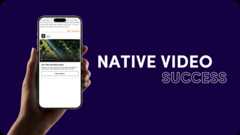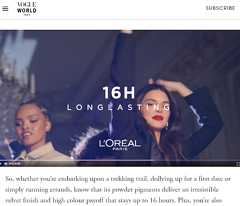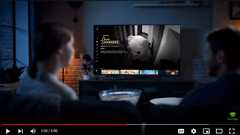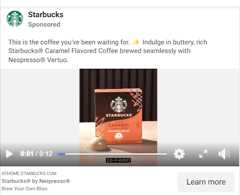

Savvy buyers are wary of traditional ads that disrupt their browsing experience on any platform. They skip, block, or simply tune out, leaving brands struggling to connect.
Despite this, video advertising remains essential forbrand visibility and growth.
So, how do you reach the right audience and hook their attention to your brand with ads?
With native video advertising.
Native ads present the content consumers love in an ad format. The result? Your ads feel like an organic part of the user experience and leave a lasting impression that traditional ads simply can’t match.
That’s why we’ve created this in-depth guide to break down the nuances of native video advertising and share tactics to maximize its impact.
Native video advertising is a strategic effort to integrate promotional content with existing content on different platforms like social media feeds, websites, or mobile games. These ads often mimic the design and feel of editorial or entertaining content. As a result, they blend in naturally rather than disrupting the user experience.
This approach allows brands to deliver marketing messages that feel organic and credible and reach audiences where they are already consuming trusted content.
4 key benefits of native video advertising
The native advertising market is projected to reach$650 billion by the end of 2032. Here’s why:
Native video ads embed with the content viewers already enjoy, making them feel less like interruptions and more like entertainment. This boosts engagement rates as these are more likely to be watched, interacted with, and remembered by the audience.
These ads fit perfectly with the format and style of platforms they appear on — whethers it’s Instagram, YouTube, or news websites. This makes your brand visible among customers on different channels, making it unforgettable.
Unlike traditional ads that can feel disruptive, native video ads match the look, feel, and function of the content around them. This smooth integration means viewers are less likely to skip or block the ads, as they don’t disrupt their enjoyment but rather enhance it.
In fact,87% of consumers prefer native advertisements over traditional banners, highlighting this approach’s effectiveness in creating amore engaging user experience.
Native video ads provide a powerful platform for brands to tell their stories in an engaging and emotional way. This helps build a strong emotional connection with the audience, making them more likely to remember and engage with your brand.
Native video ads can effectively counter ad fatigue. Since they’re less disruptive and more integrated into a platform’s native content, viewers don’t experience the same level of annoyance as with traditional ads.
This approach keeps the content fresh and engaging, ensuring that your audience remains receptive to your brand’s message without feeling overwhelmed.
Now that you’re aware of why native video ads are effective, let’s explore different types you can leverage.
In-feed video ads appear within a user’s social media feed.
Platforms like Instagram, Facebook, and LinkedIn use sophisticated algorithms to show these ads to relevant audiences. Plus, these blend with the surrounding content, making them look and feel like a natural part of the user’s feed.
This not only boosts the chances of the ads being noticed but also enhancesuser engagement by ensuring a cohesive browsing experience.
One great example is by a product analytics tool Mixpanel that has launched a video ad campaign on LinkedIn promoting its Spark AI features.
The ad starts automatically as users scroll their feed, catching attention with visually appealing graphics and key messaging about its generative AI capabilities.

In-article ads are integrated into the blog posts, offering a break from the text with a short video promoting a product or service.
Tailored to the article’s topic, these video ads offer a win-win solution for brands and readers.
For example, e-commerce brands can leverage this type of advertising to show products a user has recently browsed.
This way, brands cansell trending products by reaching their audience with highly targeted and contextual advertising, while also adding value to the readers’ experience by enhancing the content they’re consuming.
This Vogue article features a seamlessly injected video ad for L’Oreal Paris Matte Resistance Lipsticks placed after highlighting the product’s benefits. Not only does this maintain the article’s flow but also shows the product in action.

In-game video ads are revolutionizing the way brands connect with gamers. These ads are strategically placed within the video/mobile game environment – mainly on virtual billboards, buildings, signs, and other structures.
This makes them highly visible to players, effortlessly blending with the virtual world rather than interrupting the overall gaming experience.
Take Lay’s, for instance. This potato chip brand launched a 6-second video ad campaign in games like Gravity Rider Zero, targeting 18-34-year-olds in Latvia. It achieved a92.5% video completion rate and a 98% viewability rate – showcasing the true potential of in-game ads.

Sponsored content video is another type of native video ad where brands pay content creators to include their promotional content in videos that are not their own.
The goal is to engage viewers through relevant and entertaining content focused around theircustomer pain points and subtly promote the brand’s products.
When influencers authentically endorse a product within their videos, it exposes the brand to new audiences who may be unfamiliar with their offerings.Influencer marketing campaigns that incorporate such endorsements often see increased brand visibility and engagement, leveraging the influencer’s credibility to foster genuine connections with consumers.
“Partnering with technology influencers is immensely beneficial for software companies. These influencers help bridge the gap between the brand and a tech-savvy audience, offering authentic endorsements that boost credibility and enhance product visibility in a crowded market” – says Mariia Lvovych, the Outreach Manager at NAKIVO.
And since viewers trust their favorite influencer’s recommendations, they engage positively with the brand’s message.
Shea Whitney, a fashion and beauty influencer with 1.69 million subscribers, partnered with Mermaid Hair for styling tips videos. She effortlessly introduces her audience to the brand’s hair waiver, showcasing how it can help them achieve soft, natural-looking waves.

This is a strategic alliance where two iconic brands come together to create a compelling message that resonates with viewers. It often blends multiple strengths, creativity, and resources to produce a video ad, potentially tapping into each other’s consumer base.
These native ads can range from humorous and light-hearted campaigns to emotional stories that leave a lasting impression on viewers.
On April Fool’s Day 2023, Peacock and Duolingo teamed up to announce a fake reality TV show titled Love Language.
Ten confident and flirty singles from around the world, each speaking different languages, shared a house in paradise, searching for true love.
Contestants had to take daily Duolingo lessons and find a match by each episode’s end – or be eliminated by the show’s ruthless judge, Duo the Owl.
Though many viewers quickly realized it was a prank, the trailer generated excitement and drove thousands of signups for Duolingo’s free trial. This clever move didn’t interrupt anyone’s viewing – it just showed up in Peacock’s regular content feed, making the users happy.

Knowing the types of native video ads will help you design a results-driven ad strategy. Let’s look at five proven native video advertising best practices to achieve a strong ROI with your ads.
People are often wary of advertisements, but some ads manage to live rent-free in their minds.
The secret lies in making them visually appealing – a critical factor that shifts an ad from intrusive to captivating. To achieve this:

Not only do such video ads grab attention but also retain it long enough to convey a message or prompt action. Plus, it helps them stand out amongst ad fatigue, boosting engagement and conversion rates.
Here’s how Mailchimp leverages visually engaging elements in its native video ads. Plus, most of its advertisements clock in between 10-30 seconds, ensuring every second counts.

Have you ever watched a video ad that felt like a captivating story unfolding, rather than a sales pitch? That’s the power of video storytelling.
Unlike traditional hard-sell commercials, a well-crafted narrative draws viewers into a plot, keeps them engaged until the end, and even prompts them to share it with others.
A good starting point to build your ad’s narrative is by researching what resonates with yourtarget audience. Identify their interests, values, and content they engage with most. Then, follow these steps to create a script for your video ad:
Remember to be authentic. Incorporate real-life experiences and testimonials whenever possible. And, encourage spontaneous dialogues among characters, rather than scripted lines.
Here’s an interesting example by Monday.com. This 30-second ad centers on two people discussing the problem of using multiple platforms for work, and then introducing Monday.com as a solution.
While scrolling through your social media feed on your smartphone, a video ad appears that is tailored perfectly for your device – no awkward zooming or rotation required.
And, before you know it, you’ve watched it till the end.
The difference between videos that flow seamlessly on mobiles and those that are cumbersome boils down to how well they’re optimized for your mobile screen.
Here are some crucial tactics to ensure your video ad shines on the small screen:
Since a person spends an average of4.5 hours on mobiles daily, it’s not just an option – it’s essential for capturing and retaining audience attention from the get-go.
A CTA serves as a pivotal moment where you guide your audience towards the desired action – whether it’s making a purchase, visiting a website, subscribing to a newsletter, or signing up for the free trial.
Without a strong CTA, viewers may enjoy your content without knowing what to do next.
A strong CTA not only increases conversion rates but also allows you to measure your campaign’s success by tracking how many viewers responded to your call.
Here’s how you cancreate an effective CTA:
Check out this example by Starbucks. It published this native video ad to persuade Facebook users to try its new caramel-flavored coffee. Throughout the video ad, viewers are invited to take action with a simple click of the CTA button placed underneath.

The success of nativevideo advertising relies on selecting the right channel to display your ad content, whether it be YouTube, social media, display networks, or native-specific networks on the open web, such as Outbrain.
Each platform offers unique strengths and appeals to different audience demographics and behaviors.
For example, YouTube excels with longer-form videos, such as detailed tutorials, product demonstrations, or storytelling. On the other hand, platforms like Instagram and TikTok thrive on short, visually captivating videos that grab attention quickly and encourage immediate interaction through likes, comments, and shares.
Hence, understanding these platform dynamics allows you to create relevant video campaigns that deliver tangible results for your brand.
While choosing the right channel, consider the following factors:
Further, analyzing performance metrics helps you allocate your advertising budget more effectively by investing in platforms that deliver the highest return on investment (ROI).
If YouTube ads consistently show higher conversion rates compared to Instagram, you may choose to prioritize YouTube fordriving sales.
A successful marketing strategy thrives on meeting customer expectations, and native video advertising achieves this by delivering original and unobtrusive content.
Unlike traditional search, social, and display ads, native ads merge conveniently into the existing online content, giving people what they want – a seamless, non-disruptive experience.
However, simply posting native video ads is not enough. Measuring their performance is crucial to optimizing future marketing campaigns and maximizing ROI. This way, brands can refine their strategy, improve targeting, and ultimately achieve better results from their native video advertising efforts.
